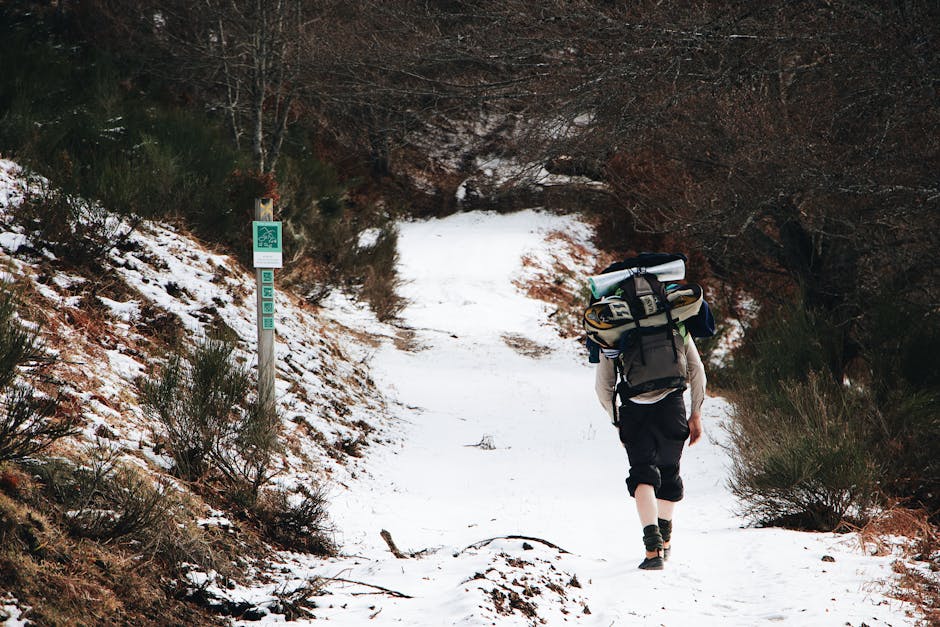Are you ready to take on the outdoors? Have you been itching to explore nature’s trails and embark on the adventure of a lifetime? Whether you’re a novice or an experienced hiker, this guide will show you how to navigate any trail with confidence. Keep reading to discover the ultimate hiking tips and tricks!

What to Pack for a Hike: Essential Gear for Every Adventure
If you’re planning a hike, there are a few essential items you’ll need to pack. Here are the basics:
A map and compass
Sunscreen
Bug spray
Hiking boots
A first-aid kit
snacks and water
An emergency whistle
A cellular phone with GPS tracking capabilities
Section 2: Understanding Hiking Safety
Before you even set foot on the trail, it’s important to understand some basic hiking safety tips. Here are a few things to keep in mind:
Stay on the trail. Don’t wander off the path. This can lead to serious injury or even death.
Make sure you’re aware of your surroundings at all times. Watch for obstacles in your path, and be prepared to stop if necessary.
When hiking in groups, keep an eye on each other’s backs. If one of your companions falls behind, be prepared to help them catch up.
Be aware of weather conditions. If it’s windy or raining, be extra cautious. Hiking in these conditions can be dangerous and difficult.

Understanding the Basics of Hiking Safety
Before you set out on your hike, make sure you have the right gear. Here are some essentials to pack for every hiking trip:
- A map and compass – These are essential tools for navigating your hike. Make sure to bring a sturdy mapcase or cover and know how to use a compass.
- sunscreen and insect repellent – It can get hot and buggy out on the trail, so make sure to wear sunscreen and apply insect repellent regularly.
- water bottle – Always carry enough water with you on the trail in case of an emergency or unexpected stop along the way.
- snacks and lunch – Pack some snacks and lunch for when you take breaks along the way, as well as something light in case hunger strikes during your hike.
- sturdy shoes – Hiking boots or other sturdy shoes will protect your feet from injury while outside, and will also provide support if you need it while walking long distances on uneven terrain or over rugged trails.
Choosing the Right Trail for Your Skill Level
When choosing a hike, consider the difficulty level and length of the trail. There is also a range of terrain you can explore, from easy trails that lead through woodlands or fields to more strenuous hikes in rugged mountains or dense forests.
Beginners should start with easier trails and work their way up as they become comfortable. More experienced hikers may choose to tackle more challenging trails. The difficulty level can be determined by how much climbing and descending there is, as well as the number of obstacles (such as rocks, roots, streams) you’ll encounter on your walk.
The length of the hike will also affect your packing list. Longer walks require more supplies (food, water, shelter), so it’s important to pack enough food and water for each day out along with appropriate clothing and gear for whatever weather conditions might arise. For example, if you’re hiking in warm weather clothes but plan to stop for lunch in an shaded area, bring sunscreen too so you don’t get sunburned while enjoying your break!

Navigating with a Map and Compass: A Beginner’s Guide
If you’re just getting started with hiking, it can be helpful to know how to use a map and compass. Here are some tips for beginners.
When you’re hiking, always use a map. Maps show the lay of the land, topography (height and width of peaks and valleys), trails, roads, and other features. They also indicate landmarks like streams or campsites that you’ll want to take note of when planning your route.
To use a map on a hike: unfold it so that the back is facing up; orient it according to your destination; identify key features (like lakes or rivers) near your destination; trace your route with a finger as you read the trail description aloud from the map; follow these directions as needed:
To locate points of interest along your hike such as springs or campsites: hold down one corner of the map while rotating it until an outline of the feature appears in pencil on top opposite where you are looking – this will help orient yourself visually during difficult hikes or when navigating in dense cover. Release the corner after sighting landmark if desired.
To mark distances between destinations: begin by drawing an X at each spot where you’ll spend the night (or any other fix point)mark additional bearings if necessary.
Now draw connecting circles around all those X’s – your “map line.” This line should be long enough so that at 1/4 mile from each end, both marks would fall within circle circumscribing entire square measuring 2 miles on each side – shoulder-to-shoulder width at arm’s length). When following this route consecutively over consecutive nights/days, double-check every mile against actual distance traveled since many GPS devices inaccurately report distance travelled); erase any unnecessary markings including highways etc.; replace original sketch with final version before tucking away into wallet or pocketbook! Be especially vigilant about erasing ALL sketches made immediately prior to reaching landmarks well BEFORE Placing Feet Onto Ground Nearby! At this point even veteran hikers sometimes make costly mistakes due to minor clues remaining ON sketch itself thereby CAUSING major headaches DAY OF! If there still seems something amiss upon arrival STOP – relax & reevaluate plan before proceeding ANY FURTHER!. Generally speaking though good mapping skills won’t typically cause much grief aside from possibly missing out on glorious scenery occasionally encountered ‘off script’…unless entering somewhere new without knowing what lies ahead which CAN happen anywhere anytime especially on those “less traveled” trails! (Remember REFLECTING back at home BEFORE setting out the next morning everything you did -hopefully!).
When using a map, always consult it ahead of time to verify your route. If you get lost, follow the map’s directions until you find the trailhead or landmark that corresponds to your original planned destination. When hiking in a group or with a partner, it can be helpful to rotate positions so everyone has an equal chance of seeing signs and markings. Always take breaks when necessary and drink plenty of fluids and avoid eating heavy foods before going on a hike.
Tips for Picking the Perfect Hiking Spot
Hiking with a group or partner can be an amazing experience. It’s fun to hike in tandem, making sure everyone gets where they’re going without any undue delays. Not to mention, it can be really rewarding to have someone else along for the journey. Here are some tips for hiking with a group or partner:
-
Make a plan before you go hiking. Planning Ahead will Help Keep Everything on Track and Allow Everyone More Fun and Flow During Your Hike. Plus, Having a Plan Prevents Any Unnecessary Stress When Out There On The Trail!
-
designate leaders and followers during your hike – this is especially important if there are multiple people in your hiking party. Leaders should set the pace while followers stay close by and follow their lead as needed (within reason). This ensures everyone stays safe while out on the trail, while also keeping thingsRunning Smoothly Accordingly!
-
communicate with one another throughout your hike – let everyone know when you’re taking a break, when you’re approaching an obstacle, etcetera so that no one gets lost or confused (especially if your destination isn’t immediately visible!). Being able to talk openly about your surroundings makes the experience that much better!
How to Prepare for Unpredictable Weather Conditions
If you’re looking to hike in a location that’s off the beaten path, be prepared for a bit more difficulty. In this section, we’ll outline some tips for hiking in difficult terrain, so you can have a more enjoyable experience.
When hiking in difficult terrain, it’s important to be prepared for any type of weather condition. Make sure you have the right gear, including appropriate clothing and gear for the weather conditions. Be sure to bring plenty of water and snacks, and be prepared to make camp in difficult conditions.
If you’re hiking with a group or partner, it’s important to communicate with each other. Make sure everyone is aware of your plans and what to do if something goes wrong. And finally, always take care when crossing streams or rivers – be aware of your surroundings and use caution when crossing.

The Benefits of Hiking with a Group or Partner
One of the great things about hiking is that it can be done in a variety of locations and with a variety of levels of difficulty. Whether you’re a beginner looking for an easy hike or an experienced hiker looking for a more challenging trail, this guide will help you find the perfect hike for you.
When planning your hike, be sure to take into account the weather conditions. Hiking in the rain or during a thunderstorm can be dangerous, so be prepared for any eventuality. And remember to always wear sunscreen and insect repellent, as these will help keep you healthy while on the trail.
When it comes to food, remember that hiking can be a long day, so make sure to bring enough snacks and water to keep you going. And if you’re planning on camping overnight, be sure to pack your camping gear as well.
Finally, when hiking with others, it’s important to stay aware of each other’s whereabouts and movements. Make sure to use common sense when hiking in groups, and be sure to stay on the trails so that others can do the same.

Staying Hydrated and Fueled on the Trail
Hydration is one of the most important parts of any hike, and it’s especially crucial in hot weather. Make sure to pack plenty of water bottles and snacks to keep you energized on your adventure. And if you start to feel sick or lightheaded, be sure to take a break and drink some fluids.

Making the Most of Your Hike: Taking Photos and Enjoying Nature
One of the best things about hiking is the sense of accomplishment you feel when you reach the summit of a peak or walk through a beautiful valley. Hiking can be a great way to get in shape, enjoy nature, and connect with other people. Here are some tips for making the most of your hike:
-
Plan Your Route ahead of Time: When you’re planning your hike, make sure to account for any obstacles or steep inclines that may be on your route. This will help you avoid getting lost or injuring yourself.
-
Bring Plenty of Water and Snacks: Make sure to bring plenty of water and snacks with you on your hike so that you don’t have to stop to get them. This will also help you stay hydrated and energized while hiking.
-
Bring a Map and Compass: If you’re unfamiliar with the area you’re hiking in, it’s important to bring a map and compass with you. This will help you navigate your way back to civilization if necessary.
-
Dress for the Weather Conditions: Always dress appropriately for the weather conditions in which you’ll be hiking. This will help you stay warm and safe in cold weather, and cool down if it’s hot out.
-
Take Plenty of Photos: When you’re hiking, take plenty of photos to remember your trip by. This will also give you a sense of accomplishment when you reach the summit or walk through a beautiful valley.
At the end of the day, hiking is a great way to get outside, stay active, and enjoy nature. After reading this guide, you should feel confident navigating any trail with ease. Remember to always prepare accordingly for unforseen events on the trail such as unpredictable weather conditions or terrain changes – be sure to check out our other content for even more tips on cheap ways to keep your gear in top condition! With these tools and resources by your side you’ll have all that you need for a successful hike. Happy trails!

